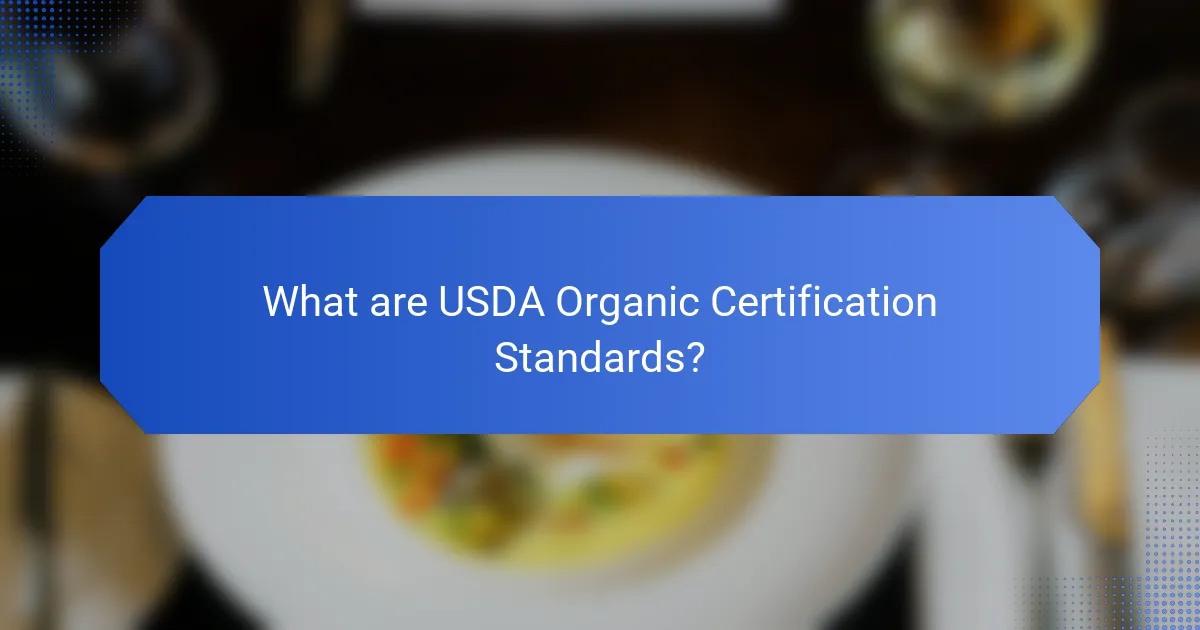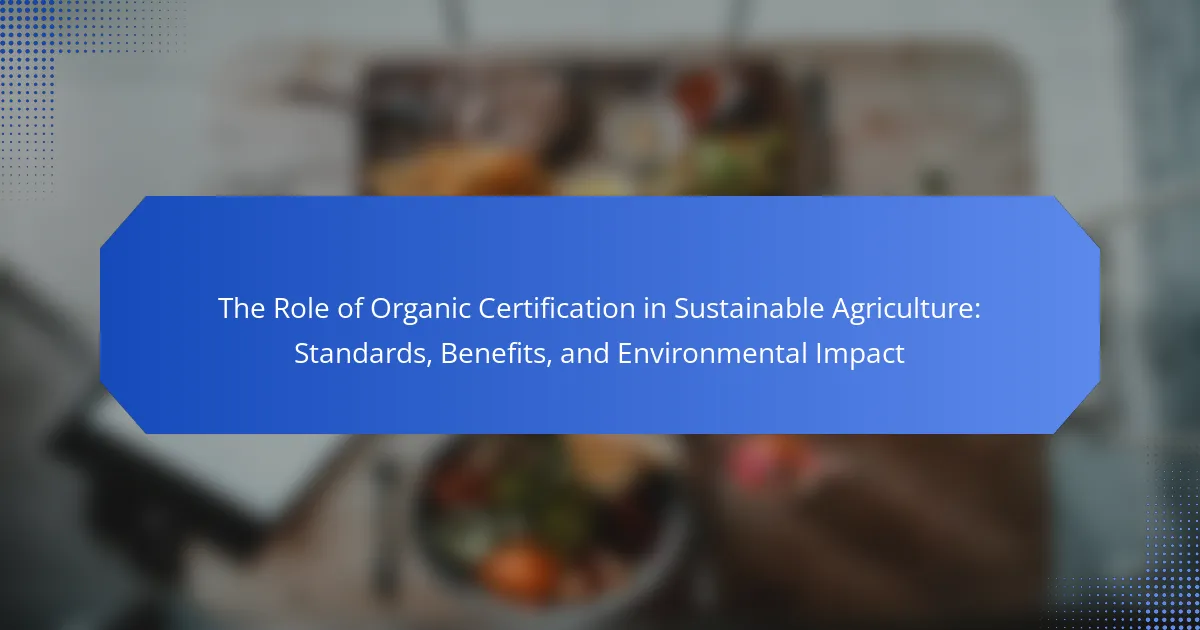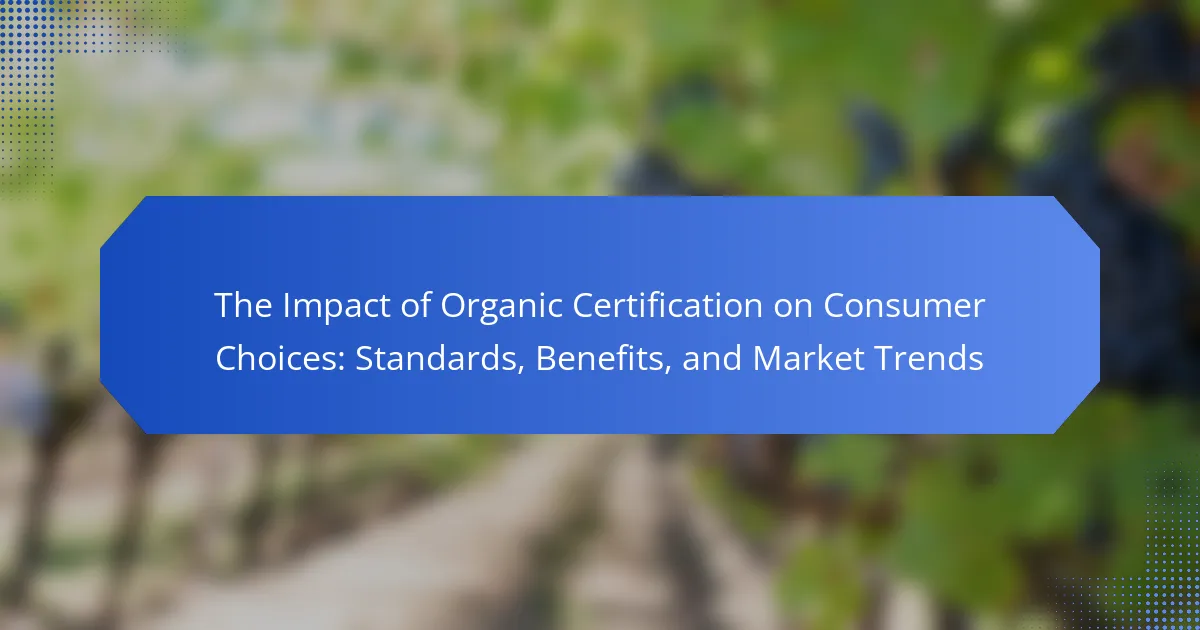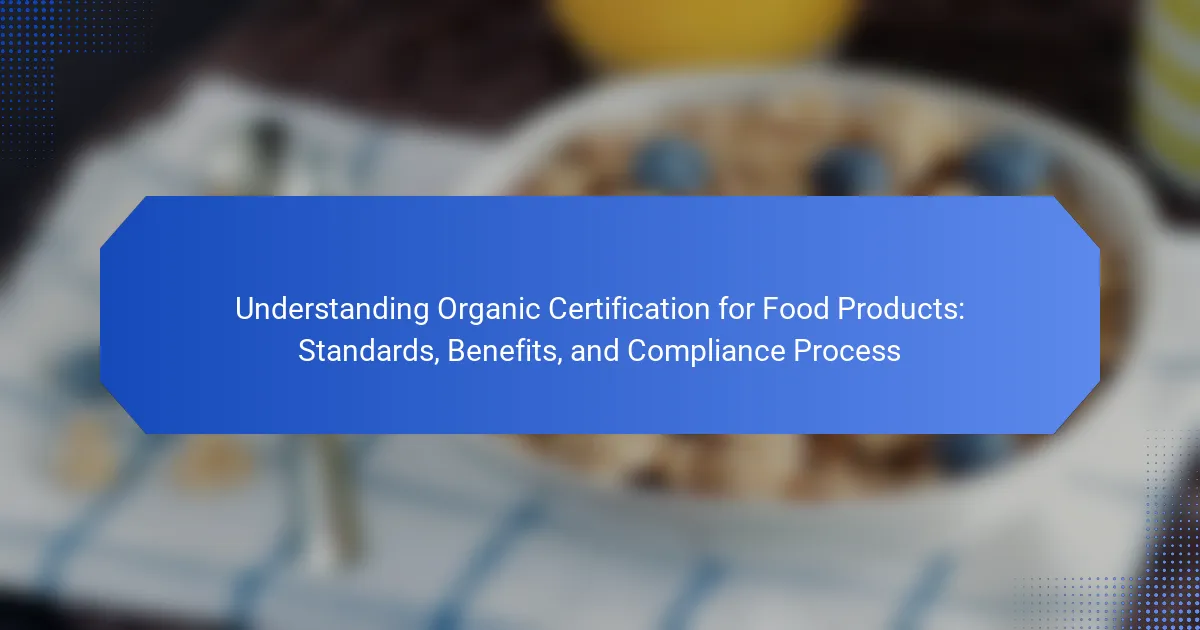USDA Organic Certification Standards are essential regulations that govern organic farming and production in the United States, ensuring products labeled as organic meet specific criteria related to soil quality, pest control, and the prohibition of synthetic substances. This certification process, overseen by the USDA through accredited certifying agents, mandates compliance with strict guidelines that promote environmentally sustainable practices and enhance marketability for producers. The article outlines the benefits of USDA Organic Certification, including potential health advantages for consumers and the economic value it adds to organic products. Additionally, it details the compliance requirements necessary for obtaining certification, including the development of an Organic System Plan and annual inspections to verify adherence to organic standards.

What are USDA Organic Certification Standards?
USDA Organic Certification Standards are regulations governing organic farming and production in the United States. These standards ensure that products labeled as organic meet specific criteria. The standards cover various aspects such as soil quality, pest and weed control, and the use of additives. Organic farming must utilize natural substances and physical, mechanical, or biologically based farming methods. Synthetic fertilizers and pesticides are prohibited under these standards. The USDA oversees the certification process through accredited certifying agents. Compliance with these standards is mandatory for any operation selling organic products. The USDA maintains a list of allowed and prohibited substances to guide producers.
How do USDA Organic Certification Standards differ from conventional standards?
USDA Organic Certification Standards require adherence to specific farming practices that promote ecological balance. These standards prohibit the use of synthetic fertilizers and pesticides, while conventional standards allow their use. Organic standards mandate the use of non-GMO seeds, whereas conventional farming may utilize genetically modified organisms. Additionally, organic livestock must be raised without antibiotics or growth hormones, unlike conventional livestock practices. Organic farming emphasizes crop rotation and biodiversity, which are not typically required in conventional farming. The USDA also requires organic products to be processed without artificial preservatives, flavors, or colors, a requirement not present in conventional standards. Overall, the primary difference lies in the sustainable practices and restrictions imposed by USDA Organic Certification compared to conventional farming methods.
What specific attributes define USDA Organic Certification?
USDA Organic Certification is defined by specific attributes that ensure agricultural products meet stringent organic standards. These attributes include the prohibition of synthetic fertilizers and pesticides, which promotes natural farming practices. Additionally, organic certification requires the use of non-GMO seeds. Soil health is emphasized through crop rotation and cover cropping practices. Livestock must be raised without antibiotics or growth hormones. Access to outdoor spaces is mandated for animals, ensuring humane treatment. Lastly, organic products must be traceable from farm to market, ensuring transparency in the supply chain. These attributes collectively uphold the integrity of organic labeling and consumer trust.
Why are these standards important for consumers and producers?
USDA Organic Certification Standards are crucial for consumers and producers. These standards ensure the integrity of organic products. They provide consumers with assurance that products are grown without synthetic pesticides or fertilizers. This leads to healthier food choices for consumers. For producers, adhering to these standards can enhance marketability. Certified organic products often command higher prices. The standards also promote sustainable farming practices. This can improve soil health and biodiversity. Overall, these standards foster trust in the organic market.
What are the key components of USDA Organic Certification?
The key components of USDA Organic Certification include the use of organic farming practices, compliance with the National Organic Program (NOP) standards, and annual inspections. Organic farming practices prohibit synthetic fertilizers and pesticides. The NOP standards require the use of non-GMO seeds. Additionally, soil health must be maintained through crop rotation and cover crops. Annual inspections ensure compliance with these standards. Certification also includes a detailed record-keeping requirement. Finally, products must be labeled correctly to indicate organic status. These components ensure that organic products meet consistent quality and safety standards.
What types of products can be certified organic?
Agricultural products can be certified organic. This includes fruits, vegetables, grains, and dairy products. Livestock can also receive organic certification. Additionally, processed foods made with organic ingredients qualify. Organic certification extends to personal care products and textiles as well. The USDA regulates these certifications under strict guidelines. Certified organic products must meet specific standards for production and handling.
What processes must be followed for certification?
The processes for USDA Organic certification include several key steps. First, an applicant must submit an application to a USDA-accredited certifying agent. This application requires detailed information about the operation and its practices. Next, the certifying agent conducts an on-site inspection of the farm or facility. This inspection assesses compliance with USDA organic standards. Following the inspection, the certifying agent reviews the inspection report and any additional documentation. If the operation meets the standards, the certifying agent issues an organic certificate. The process typically takes several months, depending on the complexity of the operation. Annual inspections are required to maintain certification.

What are the benefits of USDA Organic Certification?
USDA Organic Certification provides several significant benefits for producers and consumers. It enhances marketability by allowing products to be labeled as organic, which appeals to health-conscious consumers. This certification can lead to higher prices for organic products, as consumers are often willing to pay a premium for organic goods.
Additionally, USDA Organic Certification promotes environmentally sustainable farming practices. It requires adherence to strict guidelines that reduce synthetic pesticide and fertilizer use. This contributes to soil health and biodiversity, benefiting ecosystems.
Furthermore, certified organic products are often perceived as healthier. Research indicates that organic foods may contain higher levels of certain nutrients and antioxidants.
In summary, USDA Organic Certification increases marketability, supports sustainable practices, and may offer health benefits, making it advantageous for producers and consumers alike.
How does USDA Organic Certification impact consumer trust?
USDA Organic Certification significantly enhances consumer trust in food products. This certification assures consumers that products meet strict federal standards for organic farming and processing. It guarantees that no synthetic fertilizers or pesticides were used, which aligns with health-conscious consumer preferences. Research indicates that 76% of consumers are more likely to purchase food labeled as organic. The USDA’s rigorous inspection process further reinforces trust by ensuring compliance with organic regulations. This transparency builds confidence in the integrity of organic claims, ultimately influencing purchasing decisions.
What role does transparency play in consumer decisions?
Transparency significantly influences consumer decisions. Consumers are more likely to trust brands that openly share information about their practices. This trust translates into purchasing behavior, as studies show that 94% of consumers are likely to be loyal to transparent brands. Transparency helps consumers assess product quality and ethical standards. For example, clear labeling allows consumers to make informed choices about organic products. In the context of USDA organic certification, transparency ensures consumers understand the standards and practices behind organic claims. This understanding fosters confidence in their purchases, ultimately driving sales for compliant brands.
How does certification affect market access for producers?
Certification significantly enhances market access for producers. It assures consumers of product quality and compliance with standards. For example, USDA Organic certification opens doors to premium markets. Certified products often command higher prices. This can lead to increased profitability for producers. Additionally, certification can improve supply chain relationships. Retailers and distributors prefer certified products for consumer trust. Studies indicate that certified organic producers experience better market opportunities compared to non-certified ones. Overall, certification serves as a valuable tool for expanding market reach.
What are the environmental benefits associated with organic practices?
Organic practices promote biodiversity by fostering a variety of plants and animals. This diversity helps maintain ecosystem balance. Organic farming reduces chemical runoff, which protects water quality. Studies show organic farms have higher soil organic matter, enhancing soil health. Healthier soil supports better water retention and reduces erosion. Organic practices also lower greenhouse gas emissions compared to conventional farming. Research indicates that organic methods can sequester more carbon in the soil. These benefits contribute to a more sustainable environment overall.
How do organic farming practices promote biodiversity?
Organic farming practices promote biodiversity by enhancing ecosystem health and resilience. These practices reduce chemical inputs, which can harm non-target species. Organic farms often include crop rotation and polyculture, fostering diverse plant and animal life. This diversity supports beneficial insects and pollinators, crucial for crop production. Studies show that organic farms have higher species richness compared to conventional farms. For instance, a study published in “Agriculture, Ecosystems & Environment” found 30% more species in organic fields. Additionally, organic farming practices improve soil health, which supports a wider range of organisms. Healthy soils contribute to a balanced ecosystem, further promoting biodiversity.
What are the long-term sustainability advantages of organic certification?
Organic certification promotes long-term sustainability through enhanced soil health, biodiversity, and reduced chemical usage. Organic farming practices improve soil structure and fertility. This leads to better water retention and reduced erosion. Biodiversity is supported by organic methods that encourage a variety of plants and wildlife. Organic systems typically avoid synthetic pesticides and fertilizers. This reduces harmful runoff into water systems. A study by the Rodale Institute found that organic farming can sequester carbon in the soil. This contributes to climate change mitigation. Organic certification also fosters community resilience through local food systems. These systems often rely on sustainable practices that benefit local economies.

What are the compliance requirements for obtaining USDA Organic Certification?
To obtain USDA Organic Certification, compliance with specific standards is required. The operation must be free from prohibited substances for at least three years prior to certification. This includes synthetic fertilizers, pesticides, and genetically modified organisms (GMOs). The operation must develop and implement an Organic System Plan (OSP). The OSP outlines practices and substances used in production. Record-keeping is essential to demonstrate compliance with organic standards. The operation must undergo an annual inspection by a USDA-accredited certifying agent. The inspector reviews records and assesses practices on-site. After a successful inspection, the certifying agent issues the organic certificate. Compliance ensures that products are labeled as organic in accordance with USDA regulations.
What steps must producers take to comply with certification standards?
Producers must follow specific steps to comply with certification standards. First, they need to familiarize themselves with the USDA Organic regulations. This includes understanding the requirements for organic production, handling, and labeling. Next, producers must develop an Organic System Plan (OSP) detailing their farming practices and inputs. They should also implement practices that meet organic standards, such as using organic seeds and avoiding synthetic pesticides.
Producers must maintain detailed records of their farming activities, inputs, and sales to demonstrate compliance. After that, they need to select a USDA-accredited certifying agent to conduct an on-site inspection. The certifying agent will review the OSP and records before issuing certification. Finally, producers must comply with ongoing requirements, including annual inspections and updates to their OSP. These steps ensure adherence to the USDA Organic certification standards.
What documentation is required for the certification process?
The documentation required for the USDA organic certification process includes an organic system plan. This plan outlines the farming practices and procedures used to produce organic products. Additionally, records of all inputs used, such as seeds, fertilizers, and pest control methods, must be maintained. Documentation of the sources of these inputs is also necessary. Farmers must provide records of sales and transactions of organic products. Furthermore, annual inspection reports are required to verify compliance with organic standards. These documents ensure traceability and adherence to USDA regulations. Accurate record-keeping is essential for successful certification.
How often must producers undergo re-evaluation for compliance?
Producers must undergo re-evaluation for compliance at least annually. This annual re-evaluation ensures that producers maintain adherence to USDA organic standards. The USDA mandates this frequency to verify ongoing compliance with organic practices. Regular inspections and evaluations help uphold the integrity of organic certification. Each producer is subject to a thorough review of their practices, records, and products. This process is critical for maintaining consumer trust and market credibility. Annual re-evaluations also allow for updates to any changes in regulations or practices. Overall, this requirement is essential for the sustainability of organic farming.
What challenges might producers face during the certification process?
Producers may face several challenges during the certification process for USDA Organic standards. One primary challenge is the complexity of the regulations. The USDA’s organic standards are detailed and require thorough understanding. Additionally, producers often struggle with the documentation requirements. Accurate record-keeping is essential for compliance and can be time-consuming. Financial constraints also pose a significant challenge. The costs associated with certification and maintaining organic practices can be high. Furthermore, producers may encounter difficulties in transitioning from conventional to organic farming. This transition period can be lengthy and requires adjustments in farming practices. Lastly, producers may face market access issues. Finding buyers for organic products can be challenging if there is limited demand in their area.
How can producers prepare for inspections and audits?
Producers can prepare for inspections and audits by maintaining accurate records and documentation. This includes keeping track of all organic inputs and practices used. Regularly reviewing compliance with USDA organic standards is essential. Producers should conduct internal audits to identify areas needing improvement. Training staff on organic practices ensures everyone is informed. Organizing physical spaces for easy access to records can facilitate the inspection process. Familiarizing oneself with the inspector’s checklist can help in preparation. Engaging with a certification agency for guidance can also be beneficial. These steps enhance readiness and compliance with USDA organic certification standards.
What common pitfalls should producers avoid in the certification process?
Producers should avoid inadequate record-keeping in the certification process. Poor documentation can lead to non-compliance with USDA standards. Failing to maintain accurate records of inputs and practices makes it difficult to prove organic status. Additionally, producers should not overlook the importance of training staff on organic practices. Lack of training can result in unintentional violations. Another pitfall is not understanding the requirements for organic inputs. Using prohibited substances can jeopardize certification. Producers must also avoid waiting until the last minute to apply for certification. Delays can result in missed deadlines and lost opportunities. Lastly, failing to stay updated on regulatory changes can lead to unexpected compliance issues. Regularly reviewing USDA guidelines helps mitigate this risk.
What are best practices for maintaining USDA Organic Certification?
To maintain USDA Organic Certification, implement rigorous record-keeping practices. Document all inputs and processes related to organic production. Regularly train staff on organic standards and practices. Conduct annual internal audits to ensure compliance with USDA regulations. Maintain clear separation between organic and non-organic products throughout the supply chain. Engage with a USDA-accredited certifying agent for guidance and support. Stay updated on changes to organic regulations and standards. These practices help ensure ongoing compliance and certification status.
How can producers ensure ongoing compliance with USDA standards?
Producers can ensure ongoing compliance with USDA standards by implementing regular audits and training programs. Regular audits help identify areas that require improvement. Training programs keep staff informed about current regulations. Producers should maintain accurate records of all organic practices. This documentation supports compliance during inspections. Additionally, staying updated on any changes to USDA regulations is crucial. Engaging with organic certification agencies can provide further guidance. These actions collectively reinforce adherence to USDA standards.
What resources are available to help producers navigate certification requirements?
Producers can access various resources to navigate certification requirements for USDA Organic Certification. The USDA provides a comprehensive guide on organic certification, detailing the steps and requirements. Additionally, the National Organic Program (NOP) offers online resources, including webinars and FAQs. Local extension services often provide assistance tailored to regional needs. Non-profit organizations like the Organic Farming Research Foundation also offer support and educational materials. State departments of agriculture may have specific resources and contacts for producers. Networking through organic farming associations can also provide valuable insights and shared experiences. These resources collectively help producers understand and comply with certification requirements effectively.
USDA Organic Certification Standards are a set of regulations that govern organic farming and production in the United States, ensuring that products labeled as organic meet specific criteria related to soil quality, pest control, and the use of natural substances. The article outlines the differences between USDA organic standards and conventional farming practices, detailing key components such as compliance requirements, inspection processes, and the documentation necessary for certification. It also highlights the benefits of organic certification for both consumers and producers, including enhanced market access, consumer trust, and environmental sustainability. Furthermore, the article addresses challenges producers may face during the certification process and offers best practices for maintaining compliance with USDA standards.



